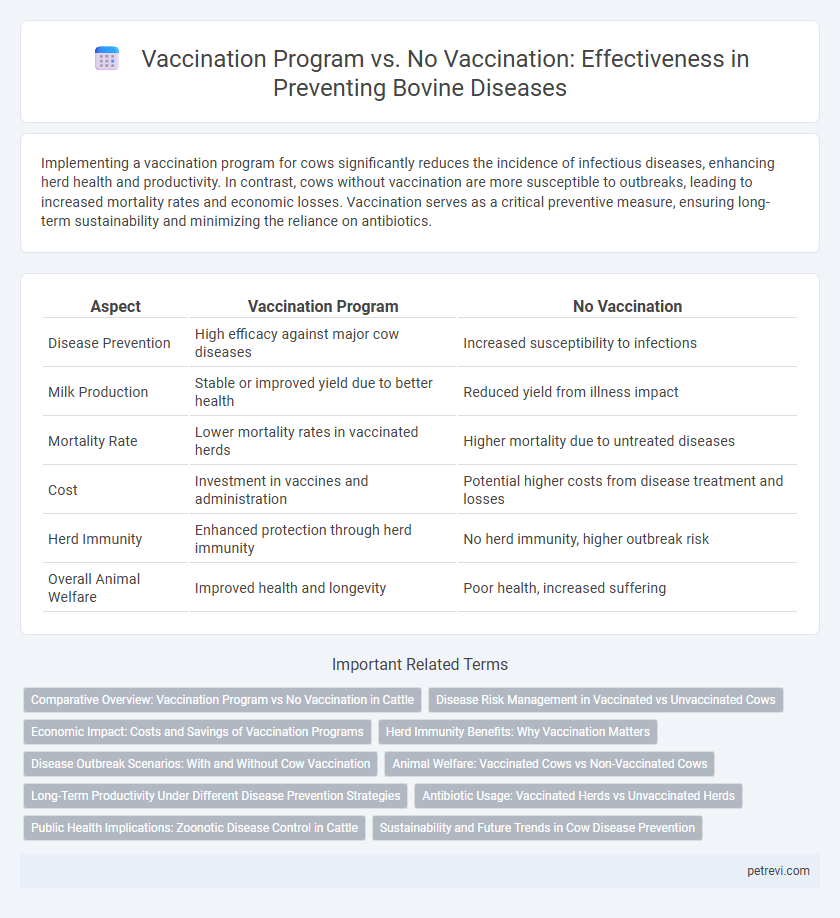Implementing a vaccination program for cows significantly reduces the incidence of infectious diseases, enhancing herd health and productivity. In contrast, cows without vaccination are more susceptible to outbreaks, leading to increased mortality rates and economic losses. Vaccination serves as a critical preventive measure, ensuring long-term sustainability and minimizing the reliance on antibiotics.
Table of Comparison
| Aspect | Vaccination Program | No Vaccination |
|---|---|---|
| Disease Prevention | High efficacy against major cow diseases | Increased susceptibility to infections |
| Milk Production | Stable or improved yield due to better health | Reduced yield from illness impact |
| Mortality Rate | Lower mortality rates in vaccinated herds | Higher mortality due to untreated diseases |
| Cost | Investment in vaccines and administration | Potential higher costs from disease treatment and losses |
| Herd Immunity | Enhanced protection through herd immunity | No herd immunity, higher outbreak risk |
| Overall Animal Welfare | Improved health and longevity | Poor health, increased suffering |
Comparative Overview: Vaccination Program vs No Vaccination in Cattle
Vaccination programs in cattle significantly reduce the incidence of infectious diseases such as bovine respiratory disease and mastitis by stimulating the immune response, leading to improved herd health and productivity. In contrast, no vaccination increases vulnerability to outbreaks, resulting in higher treatment costs, decreased milk yield, and elevated mortality rates. Implementing systematic vaccination schedules enhances disease control, promotes economic efficiency, and supports sustainable livestock management.
Disease Risk Management in Vaccinated vs Unvaccinated Cows
Vaccination programs significantly reduce the incidence of common bovine diseases such as Bovine Respiratory Disease (BRD) and Foot-and-Mouth Disease, lowering overall morbidity and mortality rates in vaccinated herds. Unvaccinated cows face higher risks of infection, leading to increased treatment costs, decreased productivity, and potential outbreak propagation within a herd. Effective disease risk management in vaccinated cows enhances herd immunity, improves animal welfare, and supports sustainable livestock production by minimizing economic losses.
Economic Impact: Costs and Savings of Vaccination Programs
Vaccination programs for cows significantly reduce the economic burden of disease outbreaks by lowering treatment costs and minimizing production losses. Farms without vaccination face higher expenses due to increased veterinary care, decreased milk yield, and potential cattle mortality. Investing in preventive vaccination yields substantial savings by enhancing herd health, optimizing milk production, and ensuring long-term profitability.
Herd Immunity Benefits: Why Vaccination Matters
Vaccination programs in cows significantly reduce the incidence of infectious diseases by establishing herd immunity, which protects both vaccinated and unvaccinated animals within the herd. Herd immunity decreases disease transmission rates, lowers veterinary costs, and improves overall livestock productivity and welfare. Without vaccination, herds remain vulnerable to outbreaks, resulting in higher mortality, reduced milk yield, and economic losses for farmers.
Disease Outbreak Scenarios: With and Without Cow Vaccination
Vaccination programs significantly reduce the incidence and severity of disease outbreaks in cattle populations by enhancing herd immunity against common infections like Bovine Respiratory Disease and Foot-and-Mouth Disease. Without vaccination, cattle herds remain highly susceptible to rapid disease transmission, leading to increased morbidity, mortality, and economic losses. Implementing comprehensive vaccination schedules lowers outbreak frequency and supports sustainable livestock health management.
Animal Welfare: Vaccinated Cows vs Non-Vaccinated Cows
Vaccinated cows exhibit significantly lower rates of infectious diseases such as bovine respiratory disease and mastitis, leading to improved overall health and reduced mortality. Non-vaccinated cows face higher susceptibility to outbreaks, resulting in increased suffering, decreased milk production, and risk of secondary infections. Effective vaccination programs promote animal welfare by minimizing disease-related pain, stress, and long-term complications in livestock.
Long-Term Productivity Under Different Disease Prevention Strategies
Vaccination programs in cows significantly enhance long-term productivity by reducing the incidence of infectious diseases such as bovine respiratory disease and mastitis, which commonly decrease milk yield and growth rates. In contrast, herds without vaccination face higher morbidity and mortality rates, leading to increased veterinary costs and reduced reproductive performance. Sustained vaccination efforts contribute to improved overall herd health, ensuring consistent milk production and growth efficiency over time.
Antibiotic Usage: Vaccinated Herds vs Unvaccinated Herds
Vaccinated herds exhibit significantly lower antibiotic usage compared to unvaccinated herds due to enhanced immunity against common bovine diseases. Studies indicate a reduction in antibiotic treatments by up to 40% in vaccinated cows, decreasing the risk of antibiotic resistance development. Efficient vaccination programs contribute to healthier herds, reduced veterinary costs, and improved overall productivity.
Public Health Implications: Zoonotic Disease Control in Cattle
Implementing a vaccination program in cattle significantly reduces the risk of zoonotic disease transmission to humans by controlling pathogens such as Brucella abortus and Mycobacterium bovis. Absence of vaccination promotes the persistence and spread of zoonotic infections like bovine tuberculosis and leptospirosis, posing serious public health threats. Effective immunization strategies in livestock are critical for safeguarding human health through the disruption of zoonotic disease reservoirs.
Sustainability and Future Trends in Cow Disease Prevention
Vaccination programs in cows significantly enhance sustainability by reducing disease outbreaks, lowering antibiotic use, and improving herd health, which leads to increased productivity and environmental efficiency. In contrast, no vaccination increases the risk of infectious diseases, resulting in higher mortality rates, reduced milk yield, and greater reliance on chemical treatments that can harm ecosystems. Emerging trends in cow disease prevention emphasize precision vaccination strategies, integrated herd health monitoring, and biotechnological advances to create sustainable, long-term disease management solutions.
Vaccination Program vs No Vaccination for Cow Disease Prevention Infographic

 petrevi.com
petrevi.com